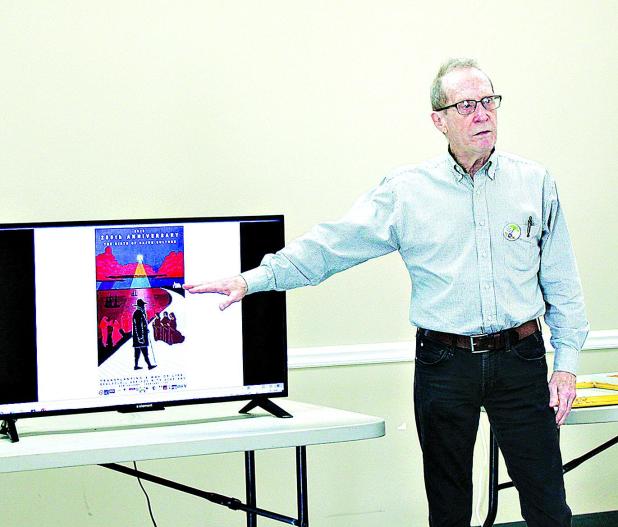
LSN STAFF PHOTO / Lisa Soileaux
Warren Perrin, guest speaker for a recent meeting of the French Table of Rayne, explains The New Acadia Project, dedicated to the identification, investigation and preservation of the original home sites and final resting places of Acadians who began what is known today as Acadiana.
New Acadia Project: Identifying, preserving homesteads of Acadian pioneers
RAYNE — “The New Acadia Project” is an effort to identify, investigate and preserve the original homesteads and final resting places of Acadians who settled in what is today known as Acadiana.
Warren Perrin, attorney from Erath, is spearheading the project and spoke recently to La Table Acadienne de Rayne (The Rayne French Table).
During his PowerPoint presentation, Perrin explained that in 1765, Joseph Broussard — also known as Beausoleil — led a group of about 200 men, women and children from Acadia, Canada, to the Gulf coast of Louisiana.
The colonial government of Louisiana provisioned the families and directed them to settle in the Attakapas District along the banks of Bayou Teche in what is now Iberia Parish. However, within months of their arrival, they were afflicted with a virulent epidemic, possibly yellow fever.
As many as 34 died between the summer and winter of 1765, including Beausoleil and his brother, Alexandre Broussard. These pioneers and founders of Nouvelle Acadie were buried at the places they had initially settled, known as le dernier camp d’en bas, premier camp d’en bas, and camp Beausoleil.
The Acadian camps and gravesites are thought to be located on the Teche Ridge, between St. Martinville and New Iberia, in the vicinity of the present-day village of Loreauville
Perrin said the historical and cultural significance of the project is made increasingly urgent by continued residential and commercial development in the region. He said the irreplaceable archaeological record and unique information it might provide on early Acadiana history and culture in Louisiana may be destroyed.
The New Acadia Project is a partnership between the Acadian Heritage and Culture Foundation, Inc., at the Acadian Museum in Erath and the University of Louisiana at Lafayette.
Archaeologists and students from UL Lafayette have discovered, recorded and investigated 33 archaeological sites at cul de sac de la Fausse Pointe since 2014, including homesteads with artifacts dating from the 18th Century and two Acadian family cemeteries with unmarked graves.
One of these graveyards is located on the 1772 Spanish patent of Claude Broussard, an Acadian who arrived at Nouvelle Acadie in 1765 with his father, Joseph Beausoleil Broussard.
The 2022 Atchafalaya National Heritage Area Grant Program supported the New Acadia Project by funding the goals of the project: archaeological and historical investigation, heritage preservation, and development of the cultural economy related to the 1765 settlement of Nouvelle Acadie.
Fieldwork during the university’s Spring Break of April 18 to April 22, 2022, was preceded by historical research and public outreach with landowners.
Archaeological and geophysical fieldwork was conducted at three previously recorded sites, identified as 16IB167, 16IB168 and 16IB196. As these sites are located on Claude Broussard’s 1772 Spanish patent, the objectives of the spring break fieldwork involved an investigation of potential associations with Camp appellé Beau Soleil.
Three UL Lafayette undergraduate students (Gloria Church, Antoine Landry and Garret Crunkleton) assisted with the site investigations. They were joined by two student volunteers (Madison Castille and Reyna Houston) and supervised by Mark A. Rees, principal investigator of the New Acadia Project, and Philip D. Bourgeois, research archaeologist with the Louisiana Public Archaeology Lab.
The crew visited the newly installed state historical marker for New Acadia in Loreauville during the fieldwork. Plans were already well underway in the spring of 2022 for the installation of an Acadian Odyssey Monument at the same location.
The Acadian Odyssey Monument and historical marker were sponsored by the New Acadia Project Steering Committee. These are the first efforts to commemorate the Acadian diaspora or “Grand Derangement” and establishment of Nouvelle Acadie at cul de sac de la Fausse Pointe.
The New Acadia Project Spring Break fieldwork began with a systematic surface collection in a sugarcane field at site 16IB167 where the crew excavated 30-cm diameter shovel tests along transects.
The artifacts retrieved include pearlware and whiteware ceramics that date from the 18th and 19th centuries.
The New Acadia Project is a long-term, collaborative undertaking in public archaeology, public history, and cultural resource management planning, according to Perrin.
The first phase of the project will involve public outreach and consultation, historical and archival research, oral history, and archaeological survey.
Individuals and organizations interested in supporting this research can contact the University of Louisiana at Lafayette Foundation or the New Acadia Project Steering Committee at the Acadian Heritage & Culture Foundation, Inc., at 203 South Broadway, Erath, LA 70533; or call 337-233-5832.
